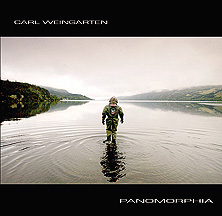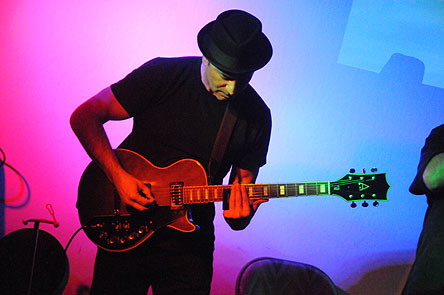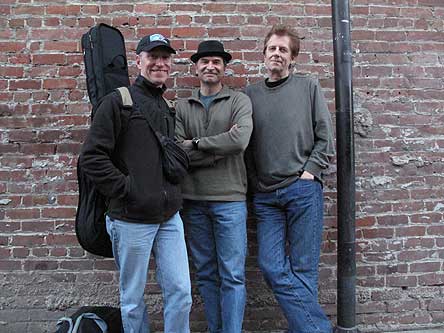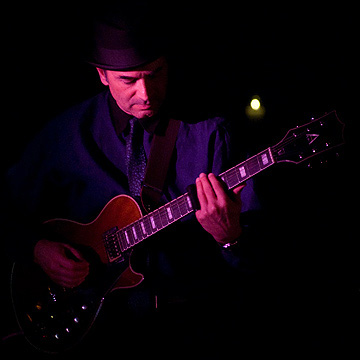 With
a history of recorded music going back 30 years, guitarist Carl
Weingarten returns in 2012 with one of his most illuminating recordings
to date. The seven track instrumental Panomorphia is
a supergroup of sorts, with Carl recording his guitars, slide guitars,
looping and e-bow in the studio, backed up by New Age / Fusion virtuosos
including Michael Manring (fretless bass), Jeff Oster (trumpet,
flugelhorn) and drummer Celso Alberti. Interestingly, Weingarten
cites guitarist Sonny Landreth as well as Miles Davis and Brian Eno
among his big influences and you can hear all that and much more on
Panomorphia. Recorded over a four year period, 2008-2012 in
Northern California, Panomorphia captures all that is best
about Weingarten’s unique brand of ambient space jazz guitar
sonics. Solid, hypnotic guitar extrapolations from a well respected,
progressive guitar icon, Panomorphia comes complete with some
praiseworthy, and totally accurate liner notes by Andy Garibaldi,the
gist of which perfectly sums up Weingarten’s unique approach
to the instrumental ambient electric guitar genre. www.CarlWeingarten.com
With
a history of recorded music going back 30 years, guitarist Carl
Weingarten returns in 2012 with one of his most illuminating recordings
to date. The seven track instrumental Panomorphia is
a supergroup of sorts, with Carl recording his guitars, slide guitars,
looping and e-bow in the studio, backed up by New Age / Fusion virtuosos
including Michael Manring (fretless bass), Jeff Oster (trumpet,
flugelhorn) and drummer Celso Alberti. Interestingly, Weingarten
cites guitarist Sonny Landreth as well as Miles Davis and Brian Eno
among his big influences and you can hear all that and much more on
Panomorphia. Recorded over a four year period, 2008-2012 in
Northern California, Panomorphia captures all that is best
about Weingarten’s unique brand of ambient space jazz guitar
sonics. Solid, hypnotic guitar extrapolations from a well respected,
progressive guitar icon, Panomorphia comes complete with some
praiseworthy, and totally accurate liner notes by Andy Garibaldi,the
gist of which perfectly sums up Weingarten’s unique approach
to the instrumental ambient electric guitar genre. www.CarlWeingarten.com
mwe3.com
presents an interview with
CARL WEINGARTEN
mwe3: How did you come up with the concept of Panamorphia and
how did the chemistry of the musicians on the CD add to the overall
sonic structures?
 CARL
WEINGARTEN (CW):
Thank you for doing this interview, Robert. It’s really good
to talk with you again. The title refers to immersing oneself into
the expanse. I was after a big sound on this record, but “Big”,
as in close up and intimate. It's like standing in front of a ship
or at the base of a mountain or at the ocean’s edge. The cover
image of the diver walking into Loch Ness Lake pretty much says it.
I’ve been doing guitar looping for over 30 years and I wanted
to take the technique in a fresh direction. So I went the extra mile
with this release. It’s been very gratifying.
CARL
WEINGARTEN (CW):
Thank you for doing this interview, Robert. It’s really good
to talk with you again. The title refers to immersing oneself into
the expanse. I was after a big sound on this record, but “Big”,
as in close up and intimate. It's like standing in front of a ship
or at the base of a mountain or at the ocean’s edge. The cover
image of the diver walking into Loch Ness Lake pretty much says it.
I’ve been doing guitar looping for over 30 years and I wanted
to take the technique in a fresh direction. So I went the extra mile
with this release. It’s been very gratifying.
mwe3.com: It must have been great playing with such amazing musicians
as Jeff Oster and Michael Manring, the CD features such awesome sounds.
CW: Chemistry is everything. I’m a very hands-on producer,
but I believe in letting musicians do what they do best. Give some
direction, be clear, keep it simple, and then get out of their way.
If you stick charts in front of players, you’re going to get
more reading and less inspiration. Much of Panomorphia started
out as loop-guitar improvisations I spent several weeks recording
in my studio. I edited the performances down to the most expressive
material. I wanted Michael, Celso, and Jeff to go through the same
discovery I did. It’s like putting everyone on the same runway
and taking off from there.
I’ve known the guys for years now, and we have a great working
relationship. They understood that this wasn’t just a punch-the-clock
recording gig. They helped shape the music. The guys each have their
own sound too which added depth to the music. Manring’s bass
sound is unmistakable. There isn’t much he can’t do on bass
guitar and he’s constantly exploring new techniques, which is
inspiring. Celso brought phenomenal percussion skills, energy and
personality to the music. He locked up beautifully with Michael. Jeff
and I worked closely on our two songs. Jeff has a million dollar trumpet
tone with a wide range. In the shows we do together as Blue Eternity,
it’s not unusual for him to go from a brassy fat Herb Albert
to the tiny whisper of Miles Davis in the same song.
mwe3:
What guitars are you featuring on Panamorphia and how has your
choice of guitars changed over the years?
CW: I only have one electric guitar and it’s the only electric
I’ve ever owned. Probably made in the 1970s, it’s a Japanese
copy of a Gibson Recording model that I bought from my younger brother
David. I’ve had the guitar modified over the years, but the pickups
are the same. The guitar has this weird, unique sound that suits the
music I do. I also own several acoustic guitars as well, including
two resonators, a Regal dobro, and a single cone steel guitar. Lately,
the one I’ve been playing most is my Martin Backpacker. It’s
a small portable guitar, but the tone resembles a beautiful blend
of guitar and mandolin. It turned out to be an excellent slide guitar,
too.
 mwe3:
What types of pedals and effect do you favor to process your sound
and get different sonic textures?
mwe3:
What types of pedals and effect do you favor to process your sound
and get different sonic textures?
CW: The pedals I use the most these days are performance tools
rather than sound processors. I met Brian Eno a few years ago and
got to talk with him briefly. I mentioned the arms race of sorts going
on with audio gear and all the pressure to keep up with the latest
technology and how for many artists, including me, the time and cost
was taking away from the act of making music. He said to forget all
that, and “just use the tools you need.” To make his point,
he showed me his cell phone and said, “All this does is make
calls.” No camera, no apps, etc, because that’s all he wanted.
I then told him I didn’t even have a cell phone and he laughed!
So taking Eno’s advice, I started paring things down and focused
on the music I wanted to make rather than the gear I wanted to use.
I have several cases full of analog and digital pedals going back
to the early 80s. In the studio, I use whatever tools I need for tracking.
For my live rig, I’m limited to what I can carry, so the chain
gang is usually two or three delay loopers, compressor, volume/wah,
distortion and my Blues Junior amp. My aim to is get as many sounds
out of the guitar as possible through my playing first, then use effects
to add color.
I’ve been playing slide guitar for over 35 years. The slide is
the best low-tech tool ever. It can be played at any position on the
strings, which makes for all kinds of harmonic possibilities. I have
two primary slides for electric guitar: a laboratory grade plexi-glass
tube and a Mudslide ceramic. For acoustic, I use brass, a heavy bottleneck
glass, or a custom-cut Iron Wood slide.
mwe3: The new album is surely a result of the early years and ground
breaking sounds you pioneered during the 1980s and ‘90s with
Delay Tactics. How would you compare Panamorphia with some
of your earlier material?
CW: Delay Tactics reflected a big part of my musical development,
but I feel pretty far from that material at this point. DT
had its own unique sound that Walter Whitney, David Udell, and I accomplished
together. For us, experimental music was fun. DT was beat box-driven
ambient pop and we’d go way out there on the synth and guitar
solos. John Dilberto of Echoes Radio referred to Delay Tactics
as the 80s version of The Ventures. We were among the first
indie bands to use digital effects and loop pedals. I still have my
original issue 1983 Electro-Harmonix 16 Second Delay unit. Our two
LPs (Out-Pop Options 1982, Any Questions? 1984) got
national radio play and Musician Magazine gave us a featured
review. Unfortunately we never toured, so the band went undiscovered.
mwe3: A lot has changed for recording in the last 32 years.
CW: Yes, much has changed. As a musician who was part of the indie
music movement in the 80s, I think it’s great that anyone can
make and distribute their recorded music now. Unfortunately, that’s
also become a problem... it’s too easy, so everyone does it,
whether they’re ready for prime-time or not. The music market
is over-saturated and the media and internet corporations like Apple,
Amazon, and Spotify operate just as unfairly as major labels did.
I’ve chosen not to participate in digital distribution for the
time being. The numbers don’t add up for me and I’ve come
to realize that promotion strategies, like giving music away, don’t
work when everyone else is doing the same thing. In fact, after I
pulled several of my MP3 albums off Amazon and CDBaby recently, my
CD sales went back up.
 mwe3:
Your musical influences are extensive but in what way would you say
you integrate your musical and guitar influences, that as I was reading,
range from Morricone and Eno to Vivaldi.
mwe3:
Your musical influences are extensive but in what way would you say
you integrate your musical and guitar influences, that as I was reading,
range from Morricone and Eno to Vivaldi.
CW: I’ve always been an avid music listener. I’ve been
collecting music since I was a teenager. I seek out as wide a range
of music as possible. The more music I hear and enjoy, the more I
can bring back into what I do. For example, I’m not a Tuva singer,
but the vocal harmonies and tones I heard in concert inspired me to
find my own way to express that sound. I’m not a classical musician,
but classical music has lasted hundreds of years for good reason.
I’m inspired that a simple melody from the 1700s still sounds
beautiful today. When producer Kavi Alexander invited me work with
classical Indian musicians, I immediately heard a bridge between Hindi
meditations and American blues and began exploring eastern scales.
Over time, all influences sink in. I’m at the point where I’m
no longer conscious of them at all. I play what feels right and it
comes across in my own style.
mwe3.com: Do you still listen to music and what artists still move
you and how about any new artists you like?
CW: I almost always have music on when I’m at home. Often
I’ll listen to new stuff when I’m relaxing and then to favorites
when I’m doing chores. Recently, I’ve been collecting the
Pop Ambient series on the Kompakt label. There are a lot of
good new artists, but honestly, I don’t find many that have much
to say after one or two CDs. Compilations and internet radio are a
good way to discover new music. Nothing, however, beats a good record
store experience. Walking in to Amoeba Records is like entering a
global supermarket. It’s all right in front of you. My personal
favorites are too many to list. Lately I’ve been listening to
Paul Desmond, (recent) Eno, Loscil, Miles Davis, Terje Rypdal, David
Torn, Duane Allman, Shawn Colvin, Shelby Lynne, McCoy Tyner, and Chick
Corea. As for slide guitarists, I’ve listened to everyone at
one point or another. There’s been a genuine resurgence in slide
guitar in recent years. None better than Sonny Landreth, whom I’ve
been friends with for about 10 years. A few weeks ago I was floored
when Sonny mailed me a copy of his new instrumental album, Elemental
Journey, along with a note saying how much he liked Panomorphia.
mwe3: Can you say something about your photographic career and
your other current interests and causes of late? Speaking of moving
pictures, I noticed that picture of you on your Facebook page where
you found a bullet on the streets of San Francisco. How did you come
upon that and what did you make of that?
CW: I’ve been taking pictures since I was seven or eight
years old. I had hopes of being a filmmaker. I focused on movies from
junior high school through college, where I majored in cinema production.
But even after I became a musician, photography remained a passion.
I always have a camera with me. At the end of the day, I’m a
visual artist who’s channeling that into music. It’s not
unusual. Both Tony Levin and Andy Summers are also photographers.
Again, the more I involve myself with the other arts, the more I bring
something back to my own work. Creative connections are more complicated
than we can imagine.
 It’s
interesting that you mention the bullet photo. I found that casing
on my way to work. I pass the same corner each day, so it must have
recently fallen there. Oakland has come a long way, but sadly there’s
still a lot of poverty there as well as violence.
It’s
interesting that you mention the bullet photo. I found that casing
on my way to work. I pass the same corner each day, so it must have
recently fallen there. Oakland has come a long way, but sadly there’s
still a lot of poverty there as well as violence.
mwe3: How about future plans for you into 2013? Are you planning
any new musical projects or performances?
CW: I have several new projects happening. I tend to work on several
things at once until I settle into the next release. Look for a remixed
song from Panomorphia and then an ensemble album with about
15 musicians for next year. I’ve been performing ambient-jazz
shows with Jeff Oster and Michael Manring as the group Blue Eternity.
We’ll be performing in the Bay Area this fall, including a festival
and planetarium shows. I’ll also be at the International Looping
Festival in Santa Cruz this October.
Thanks to Carl Weingarten @
www.CarlWeingarten.com



